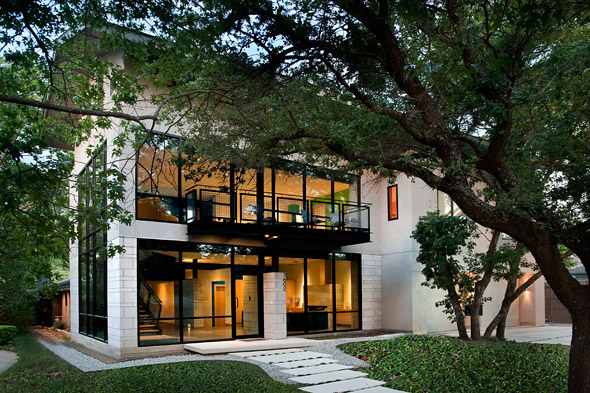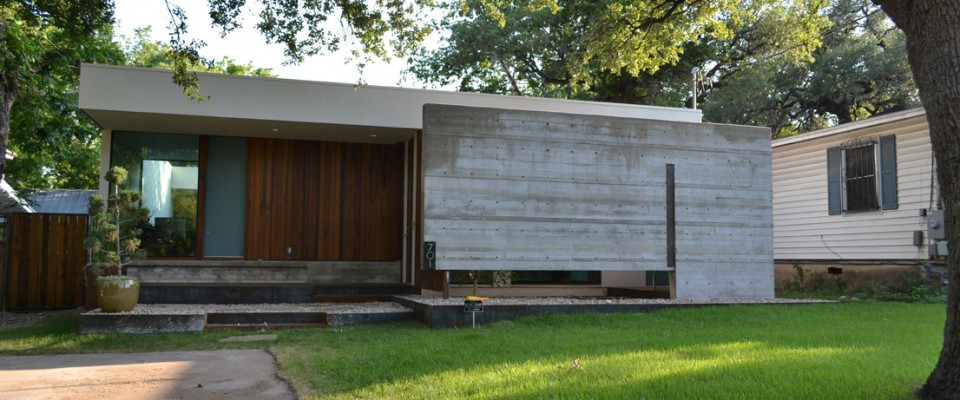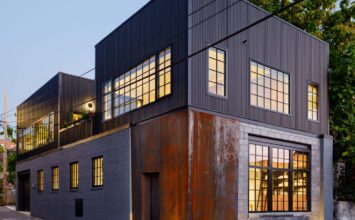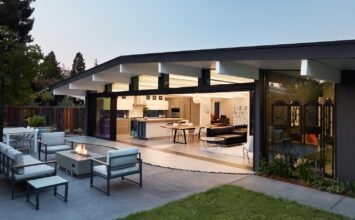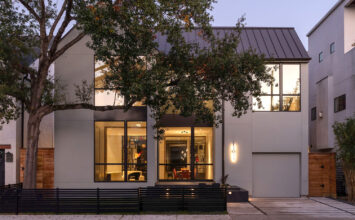This home in Menlo Park is minimalist, modern, and comprised of a series of pavilions connected by glass walkways that surround a central courtyard
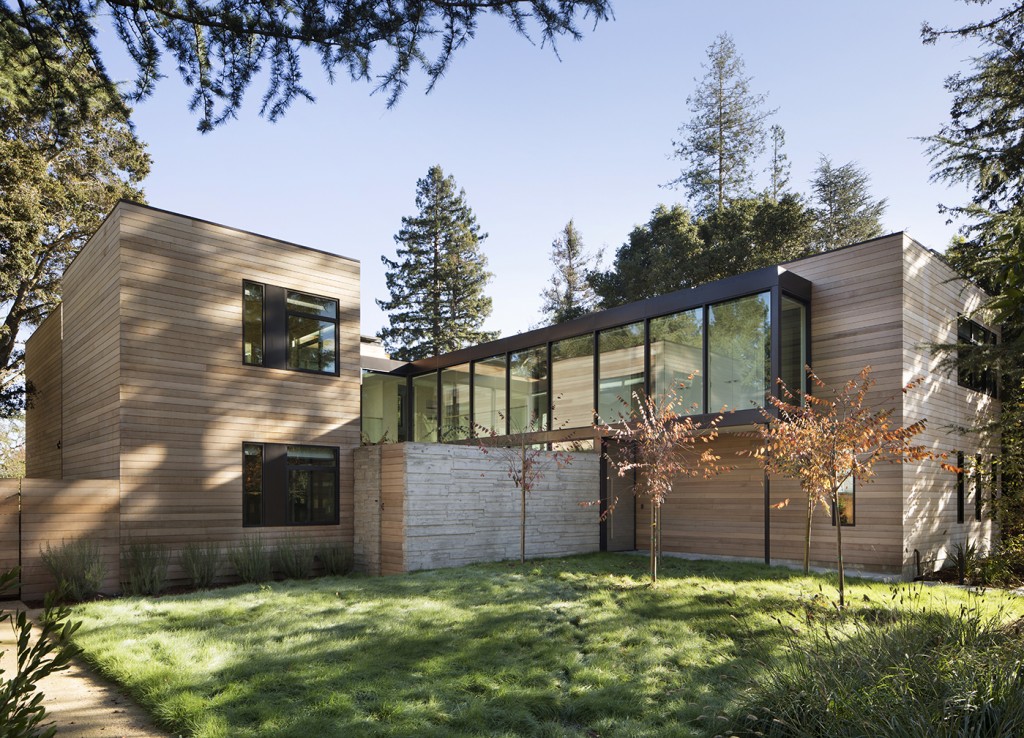
When John Lum Architecture was approached in 2012 for this project, the clients had already purchased a house in a Menlo Park neighborhood with unusually wide lots. They took down the original ranch-style home to build a new one that would suit their needs on this flat, half-acre lot that included a heritage Redwood and mature oak and maple trees.
Functionality was a driving factor in the design, and Lum was essentially given a blank slate with a few wishes to begin. The clients expressed a desire for a home with a modern aesthetic. At the same time, they needed something casual and able to sustain the wear-and-tear of two active teenage daughters (one being a soccer aficionado). Each daughter must get her own suite, and the adults needed a home office. Essentially, everyone should be able to have their own space, both during the day and at night. But the key would be a main living area in the form of a great room that would connect the individual rooms and activities together. Connections between all spaces were key.
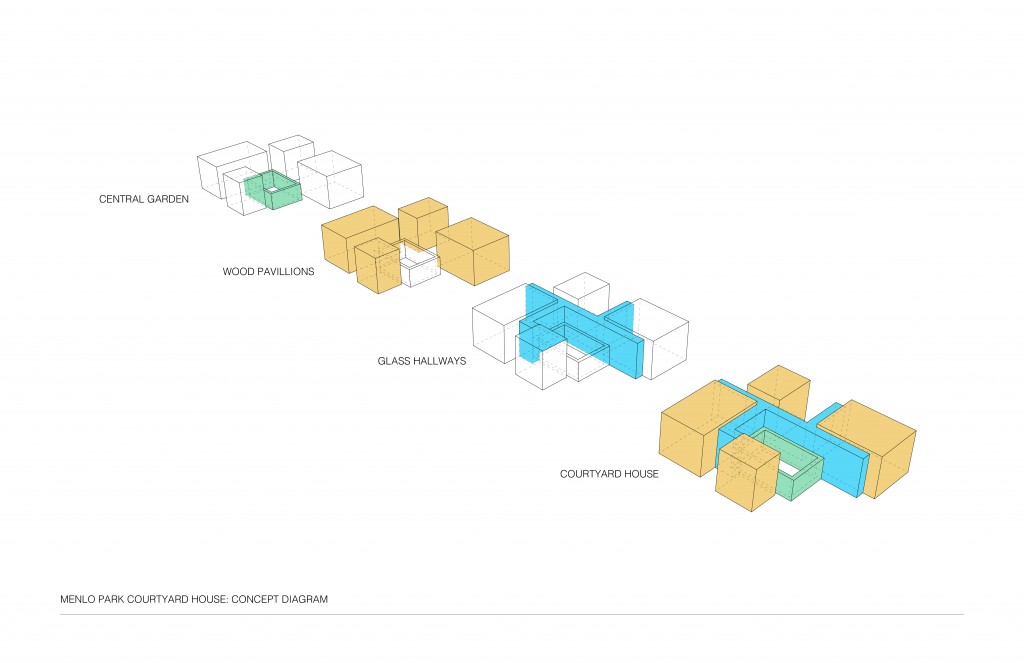
In the end, the two-story home was conceptualized as four pavilions around a garden. Each pavilion contains distinct functions related to the family needs, e.g. sleeping, exercising, working, living. Connected by glass walkways, the pavilions form a three-sided outdoor courtyard that literally places the courtyard garden in the center of the house. Because of the large floor-to-ceiling glass walls and sliding doors, it’s hard to distinguish what is inside and what is outside.
In addition to having a modern, open, and durable home, the clients needed energy efficiency. Passive energy strategies drove the design to meet their demands, as well as California’s notoriously strict energy building codes (happy to report this home meets all of them, and then some!). Large expanses of operable windows and glass doors maximize daylighting and cross ventilation. Skylights provide stack-effect ventilation and work in concert with the fenestration to pull in daylight and air. Due to the mild climate, a whole house fan is used to bring in cool evening air and lower the ambient temperature. For extreme months, radiant heating in the floors and a high-efficiency a/c unit provides user-control. To offset annual electricity costs, a rooftop solar photovoltaic array provides renewable energy.

Approaching the home, one of the first thing visitors will notice is the reduced material palette of western red cedar, blackened steel, glass, and concrete. The goal was to use long-lasting, safe, and resilient materials that require little maintenance (e.g. the wood has a light carbon footprint and less embodied energy than other building products). The materials convey durability, honesty, and transparency, and create a restrained modern vision in a neighborhood that is typically known for faux historical styles.
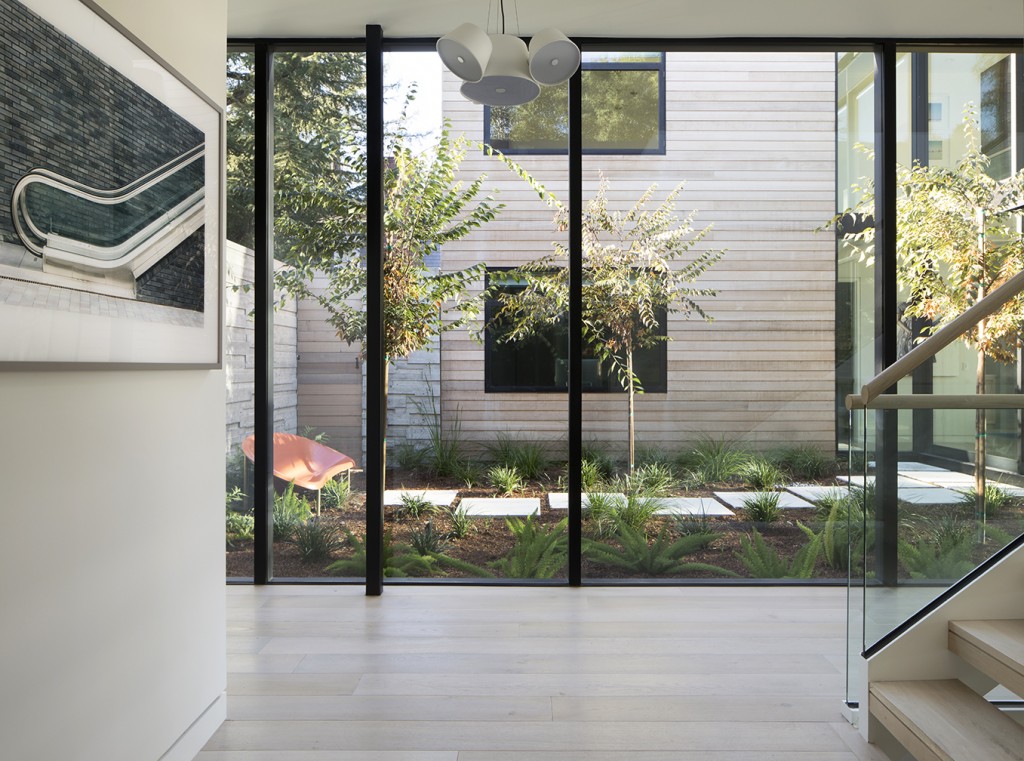
Another component of the efficiency is the radiant heating in the floors. Because it is more efficient and uses a gas-fired hydronic system, the floor-based heating uses minimal electricity compared to conventional forced-air heating systems. It provides a healthier indoor air quality, as allergens are often kicked-up with traditional duct-systems, and the system is quiet because there are no fans.

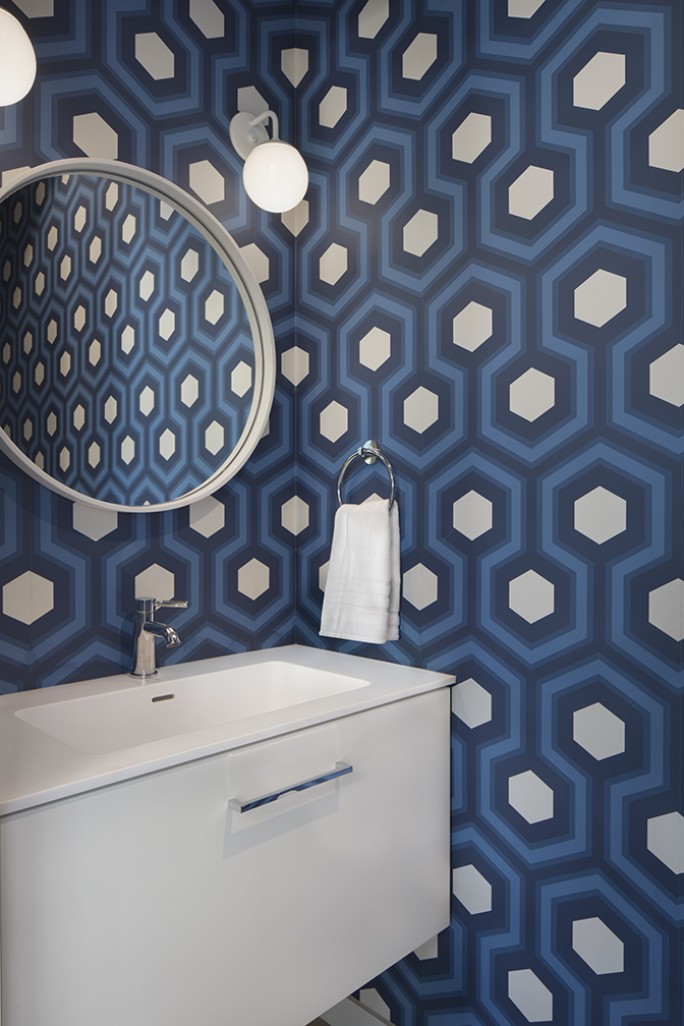
Stephanie Zaharias Design was enlisted to help finish the interior of the home. Her choice of bold colors, inviting-but-durable fabrics, and an extensive, irreverent art collection add to the warmth of the house, something visitors will notice throughout. The first-time visitors catch a glimpse of her work is in the powder room near the entrance, which features a blue hexagonal wallpaper pattern.
The powder room abuts the garage (making up the first pavilion) and is adjacent to the mud room that serves as the family and friends’ entrance. The stairs leading to the second floor are straight ahead; underneath is the staircase leading down to the basement – a rare sight in a California home. The stairs feature a custom steel box stringer with open wood treads, allowing the guard rails to slip cleanly into the steel plates. The overall look is quite gorgeous.

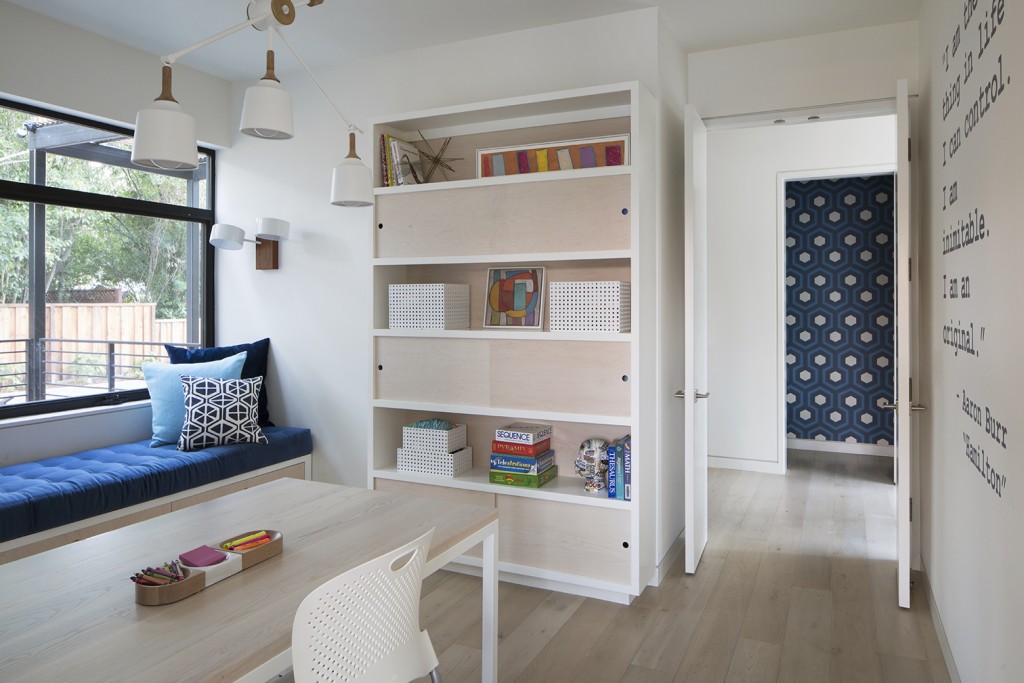
Across from the powder room is the start of the second pavilion and the first of the home offices. This one is for the girls; a room that is getting a lot of use due to the pandemic and remote learning. Large windows let in plenty of light and a bench offers a comfortable place to sit in the bay window. The desk is built into the wall and there is plenty of storage for two students to keep their work organized.
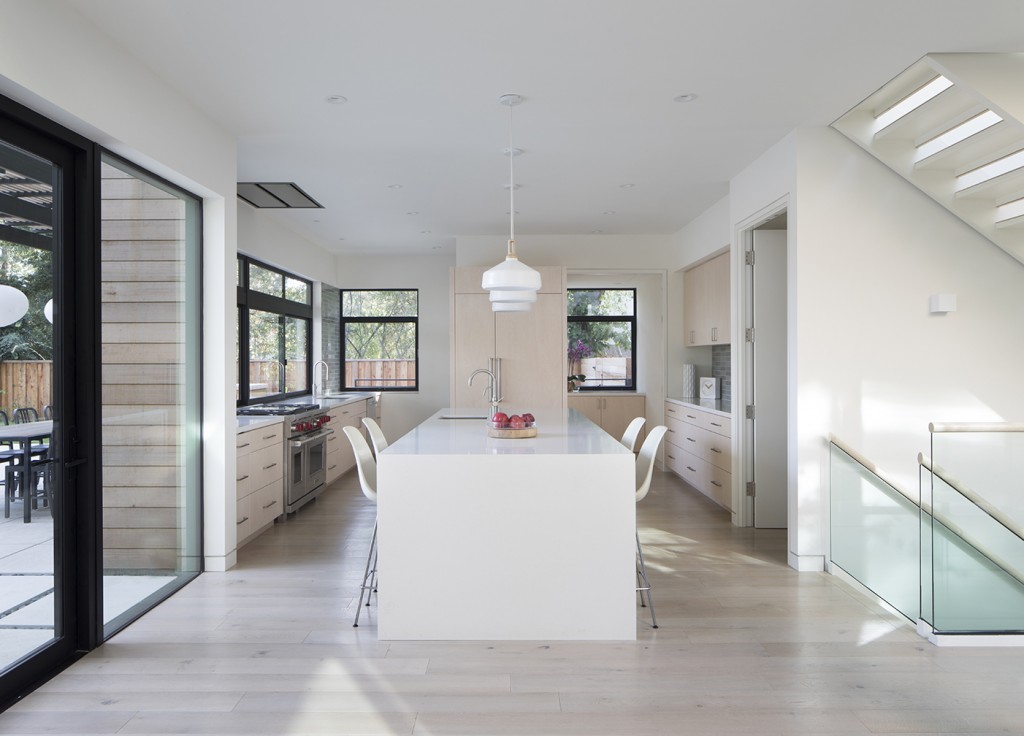
From the student office, guests can step directly into the kitchen. Incredibly well laid out, this modern kitchen sports large windows on both its exterior facing walls. The appliances are all top-notch and the refrigerator/freezer has been paneled to blend in with the rest of the cabinets and drawers. A kitchen island in the center has an easy-to-access sink, while another sink and the dishwasher are pushed into the corner, keeping the mess somewhat secluded and off to the side. Opposite the sink and dishwasher, hidden behind the refrigerator, is the large pantry.
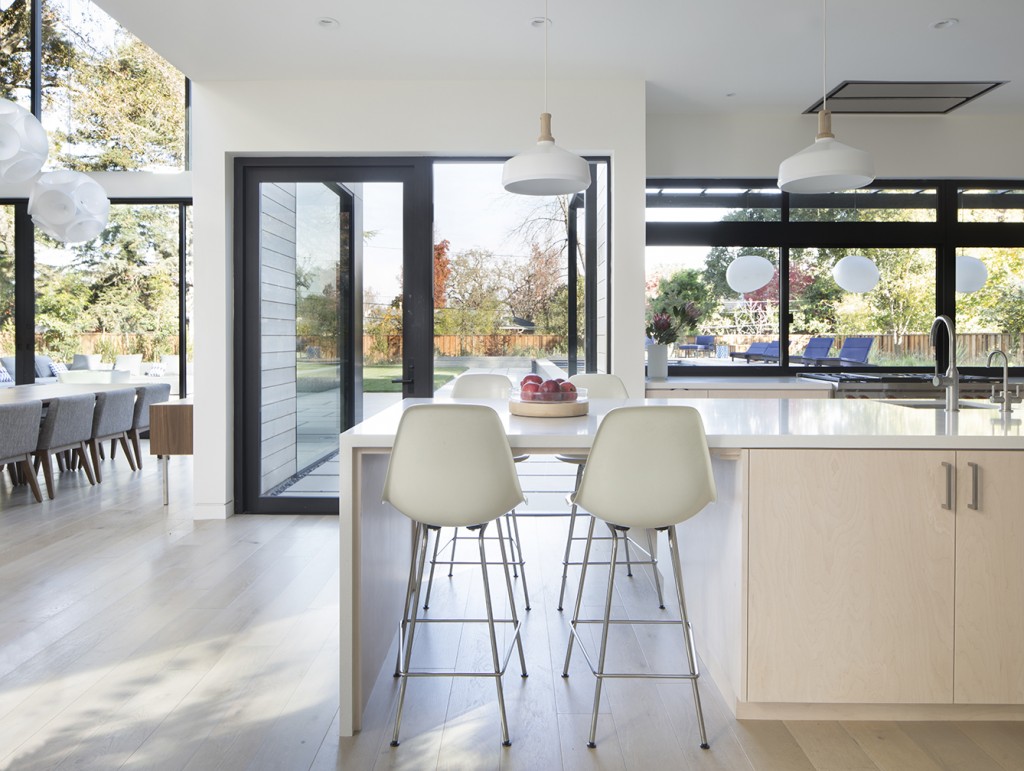
Finally, the kitchen island counter extends past the solid/storage portion to create a small table for four with a seamless waterfall edge. The whole family can have an intimate meal here, together, saving the dining room for larger gatherings. The first of two access points to the backyard is also here in the kitchen. In fact, architecturally, the front door, entrance hallway, staircase, kitchen table, and glass door to the outside all align together, creating a sense of linear thoroughness from the front entrance to the back yard.
This second pavilion blends seamlessly into the largest pavilion of the home: the “great room” the clients asked for. Double-height ceilings (20’!) and floor-to-ceiling glass make this room feel as if it is truly an outdoor living space with a roof, as intended. Both sides of the room utilize sliding glass door systems to completely open to the inner courtyard on one side, and the backyard on the other. The dining table and nearby hutch are both custom designed by Stephanie Zaharias Design and fabricated by a local vendor. Mid-century modern style sofas provide space to get comfortable and watch the television that is mounted over the gas fireplace. The TV/fireplace portion of the wall is covered in giant format porcelain tiles that add an accent of color. Zaharias’ design choices are really felt in this stunning room, from the furniture to the rug to the art. The last notable element of the room: the catwalk above that brings people through this third pavilion to the neighboring fourth on the second floor. On the ground floor, the fourth and final pavilion houses the adults’ home office and a full bathroom.
The last space to explore on the ground floor is outside. The backyard is large and features three individual spaces: a kitchen with built-in grill and refrigerator, and a dining table that seats 12; a raised pool with spa; and a lounge area with firepit… not to mention the rest of the lawn that could accommodate a fairly large backyard gathering (once they are safe again).
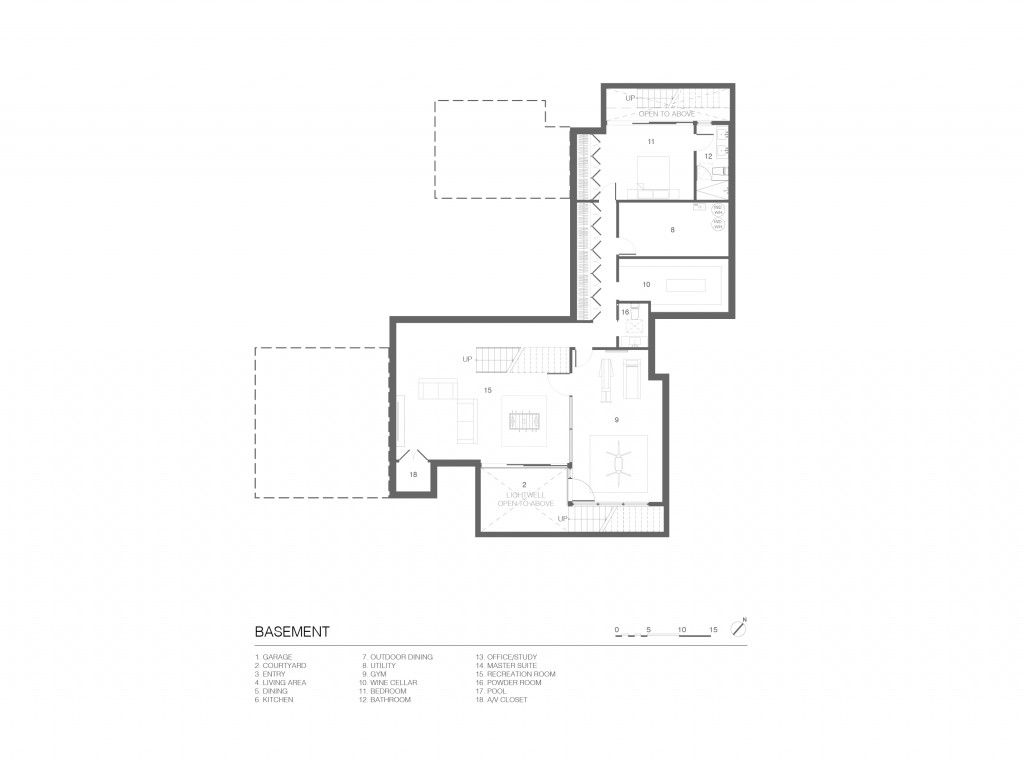
Back inside, guests should head downstairs to explore the multi-faceted basement, which includes a much-used recreation room, guest suite, gym, and wine room. To maximize ventilation and natural light in this otherwise subterranean area, lightwells were added. The main lightwell contains a staircase which allows the family to directly access the backyard from the rec room. In addition to connecting the family to nature and giving them direct access between the backyard and basement, they reduce the need for artificial light during the day; thus minimizing the amount of electricity needed (another point in the energy efficiency column). Built-in casework along the hall down here maximizes the home’s storage space and minimizes the clutter.
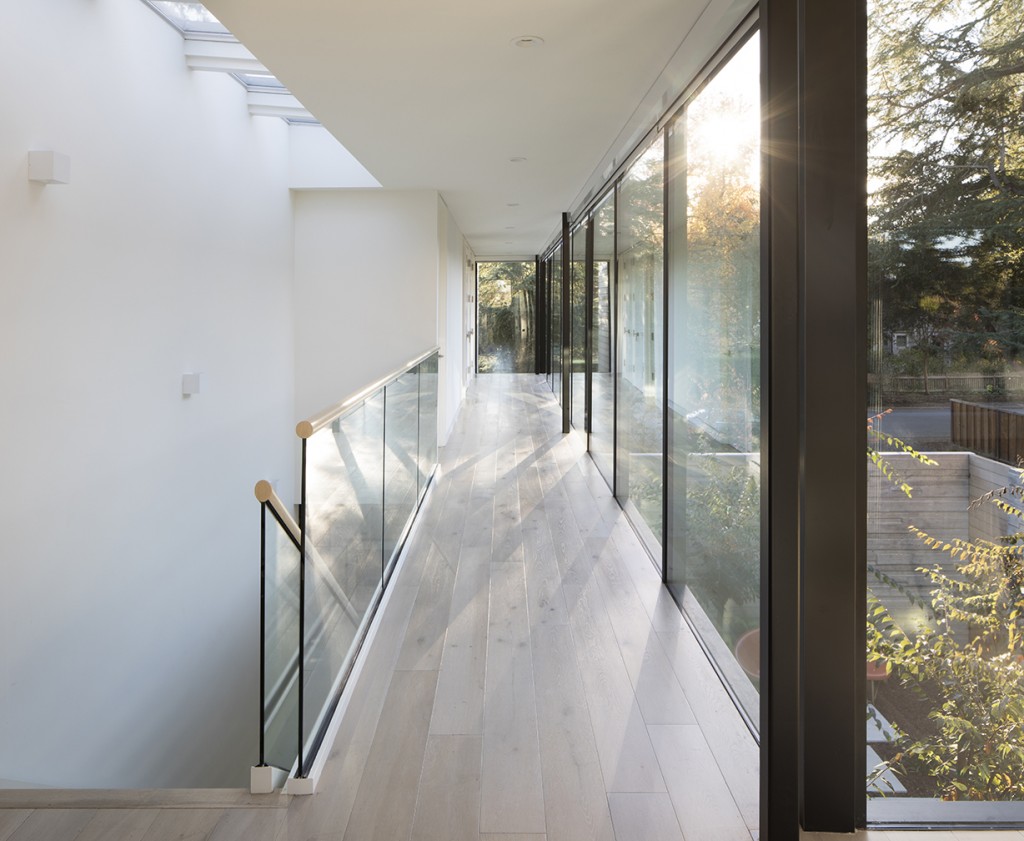
Finally, visitors can head all the way upstairs to explore the sleeping portion of each pavilion. Both daughters have their own suites, rooms equitable in size with private full bathrooms. Both bedrooms sit above the garage in pavilion one.
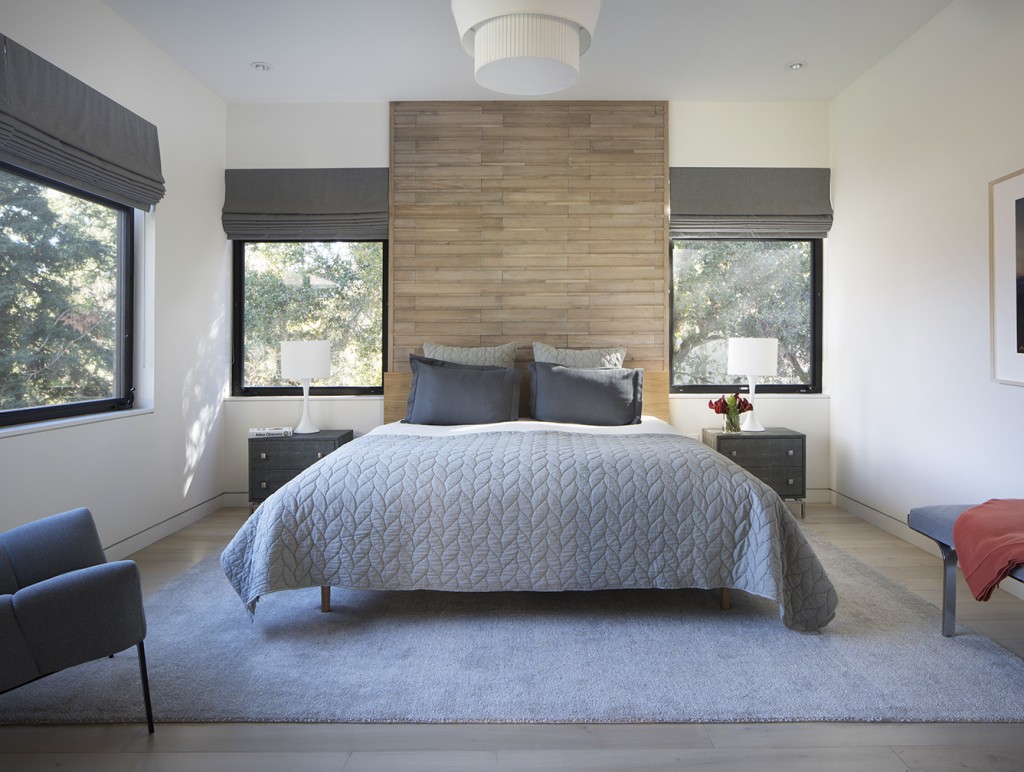
The master suite commands the second floor of pavilion two. The bedroom is located right at the top of the stairs and features large windows on its two external walls to let in plenty of light. A small hallway within the master suite provides storage space and connects the bedroom to the master bathroom and the large walk-in closet, the latter of which has its own door back out to the main hallway. So, one adult can get up in the morning and get ready for the day, without ever having to re-enter the bedroom and disturb their sleeping loved one. Brilliant design.
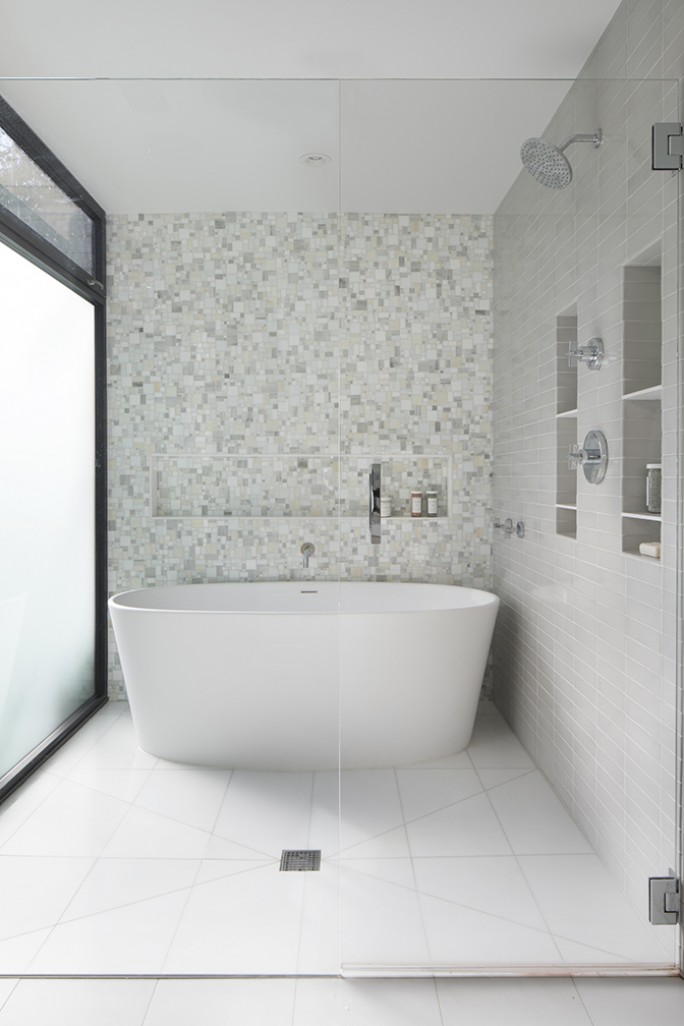
The master bathroom is generously large and luxurious with a double vanity, private lavatory area, and a freestanding tub inside the glorious shower.
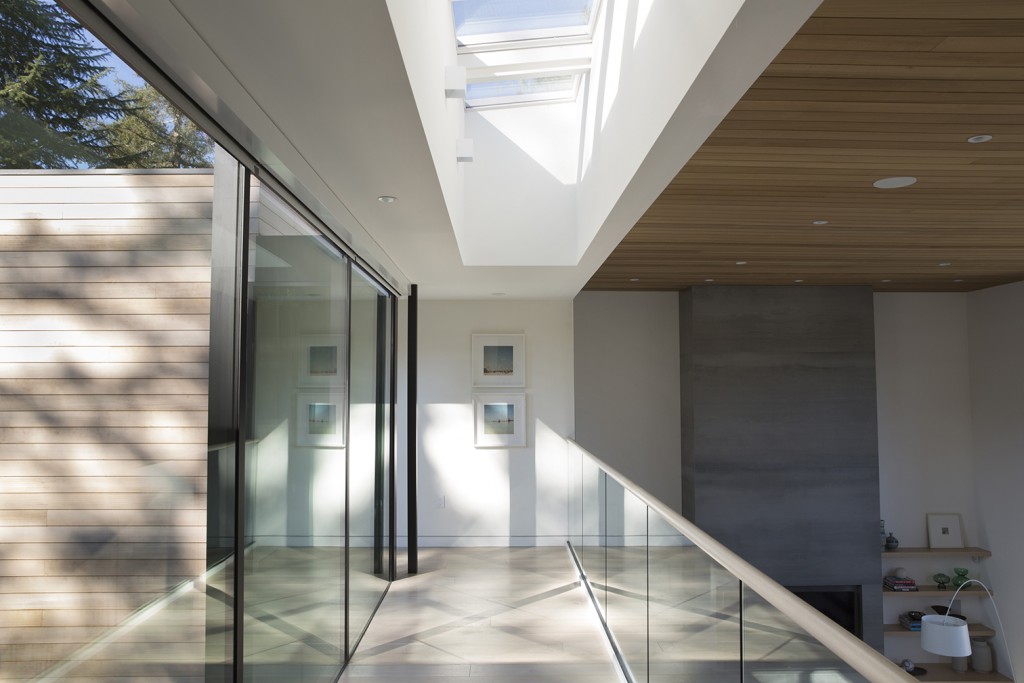
From the master suite, in pavilion two, visitors can walk across the catwalk and take in the full view of the great room. From the second floor, which is also lined with glass walls, views to the street and the entire backyard are visible. The final space to visit is a secluded guest suite with spacious bedroom and full bathroom on the top floor of pavilion four.
John Lum has designed an incredible, high-efficiency home from a relaxed, casual assemblage of spaces. The house successfully balances quietude and family togetherness with each pavilion marrying form and function. Because it was designed to be integrated with its surrounding environment, it affords easy access to the outdoors year-round… an invaluable feature for any home in 2020. These four pavilions and a garden are a perfect representation of California modern.

John Lum Architecture
Based in: San Francisco, CA
Neighborhood of project: Menlo Park, CA
Number of Bedrooms: 4
Number of Bathrooms: 6
Approximate Square Footage: 6,922
Project Completion: 2017
Contractor: Art of Construction
Interior Design: Stephanie Zaharias Design
Landscape Architect: Garden Route
Photographer: Paul Dyer Photography
Lighting: Revolver Design
Structural Engineer: Hohbach-Lewin, Inc.
Civil Engineering: MacLeod & Associates
Soils Engineer: Romig Engineers
Energy Consulting: Morton Green Building Services
Pool: Corby Gould
Fireplace: The Fireplace Element
Dining table fabrication: Pollioni Design
Refrigerator: Sub-Zero
Dishwasher: Bosch
Range: Wolf
Countertops: Caesarstone
